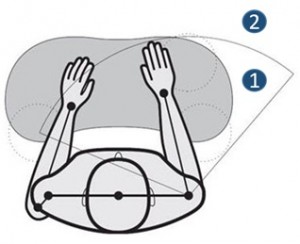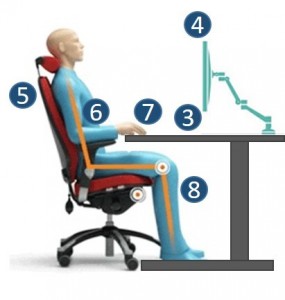DSE Workstation Advice
The NHS has some useful guidelines on the basics of a good workstation set-up: http://www.nhs.uk/Livewell/workplacehealth/Pages/howtositcorrectly.aspx, but from our experience these are the key things to consider when you are working at your desk:
- Place all things you must operate with your hands (keyboard, mouse, pen, paper, telephone)
- directly in front of you
- at elbow height
- within easy reach (1. Neutral Reach Zone for commonly used items/2. Outer Reach Zone for items used infrequently or rarely)
- Place all the things you must easily see (display, source document, writing pad, template, keyboard)
- directly in front of you at your best viewing/reading distance
- Place the display
- directly in front of you, at approximately arm’s length from you and with a natural relaxed eyelevel at the top of the screen (an area approximately 15° below the horizontal plane)
- Change your body posture often. Change helps avoid continued compression of tissues especially of the spinal column, facilitates blood circulation and counteracts muscle fatigue
- Rest your arms and hands as often as feasible – but avoid hard surfaces, especially corners and edges
- Keep the shoulders relaxed, the upper arms hanging down, the forearms horizontal and the wrists straight
- Sit at a height where your knee joint is slightly higher than your knee joint – so that your pelvic angle is open more than 90 degrees. This is best achieved when sitting slightly reclined in your chair to take the weight backwards and prevent you from having to support your body in an upright posture.
Whether you are an employer or employee, considering others and your own comfort levels is extremely important.
A persons working environment should fit the needs of the individual, rather than adopting a ‘onesize fits all’ approach.
A poor/unsuitable workstation set up can lead to a number of work related muscular skeletal skeletal disorders and possible absence from work.
Recent HSE data for 2014/15 suggests an estimated 9,466,000 working days lost due to WRMSD’s. An average of 17.1 days lost for each case.
Companies such as Shape Posture seating can offer the right advice and provide workplace assessments. Call them on 01629 814656 or visit their website www.shape-seating.com for more information on DSE Workstation Assessments and how they can help you achieve a healthier working posture.


